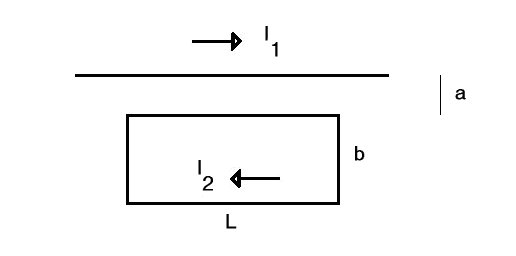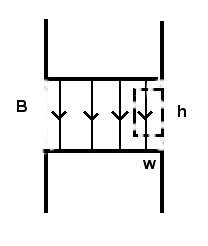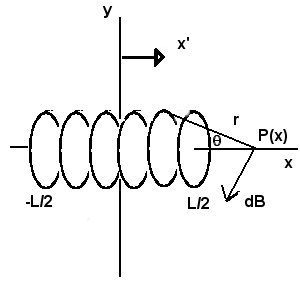

41. Apply Ampere's Law to the dashed path, to get
Integral (B . dA) = m0 Ienclosed
B h = 0
B = 0
and the last equation is a contradiction, since a magnetic field is in fact present. The only assumption in this argument is the shape of the lines of B, which must therefore be drawn incorrectly.
You can cure the problem by letting the lines of B
curve outward near the edge of the magnet. If done properly, the
integration along the horizontal sides of the dotted path can exactly
canel the integration along the vertical side inside the magnetic
field.
42.

You can find the magnetic field due to I1 by drawing a circle a distance r from the wire and applying Ampere's Law:
Integral(B.dl) = m0 I1
B = m0 I1 / (2 p r)
The field goes into the page inside the rectangular loop. By the right-hand rule, all the forces on the loop are perpendicular to the wire pointing away from the center of the rectangle. The two forces on the wires of length are the same size but opposite in direction, so they cancel. The forces on the wire closest to I1 and on the wire further from I1 are, respectively:
F1 = m0 I1I2 L / (2 p a ) and
F2 = - m0 I1I2 L / [2 p (a + b) ]
taking up to be the positive direction. The sum of these two is the net force on the loop,
F = m0I1I2 L b / [2 p a (a + b) ]
43. Done in class.

44.
Known
| Radius of coil | R |
| Length of coil | L |
| Turns per unit length | n |
| Total turns | N = n L |
Magnetic field B(x) at P
The y and z components of the magnetic field vanish
by symmetry. The Biot-Savart law for the x component of the
field in this geometry is
dBx = - m0 I dL sin q / (4 p r2)
We can also tell from the diagram that
r2 = R2 + (x - x')2
sin q = R / r
Thus q and the distance to point P is the same from any point on the loop at x'. The integral around the loop is therefore easy and gives
Bx(x) = - m0 I R sin q / (2 r2)
= - (1/2) m0 I (R2 / r3)
(The x-dependence is hidden in r). To sum over all the coils, we use the same trick we used last semester in getting the average "weight" of marbles falling onto a scale: multiply by the number of coils per meter and integrate over dx'. The expression is
Bx = - integral-L/2L/2 [n (1/2) m0 I (R2 / r3]
The integral is done by using the trigonometric substitution
x - x' = R cot q
dx' = R dq / sin2 q
where q is the same angle as shown in the diagram; in other words sin q = r / R . We get
Bx = - integralqi qf [(1/2) m0 I n sin q dq ]
which gives
Bx = (1/2) m0I n [cos qf - cos qi ]
where qi and qf are the values of q at the leftmost coil and rightmost coil, respectively. Analytically,
cos qi = {x + L/2} / {sqrt [R2 + (x + L/2)2 ] }
cos qf = {x - L/2} / {sqrt [R2 + (x - L/2)2 ] }
45. Use the diagram and notation of the previous problem.
Using the (previous) diagram the distances between P and the two ends of the coil are
ri = x + L/2
rf = x - L/2
and each r << R when P is far from the ends of the coil. Writing the magnetic field from problem 44 in terms of ri and rf, we get
Bx = (1/2) m0 I n [rf / sqrt(R2 + rf2 ) - ri / sqrt(R2 + ri2 ) ].
Expanding in terms of the small ratio ri/R we have
ri/ sqrt(R2 + ri2) = (ri / R) / sqrt(1 + ri2 / R2 ) = 1 - R2 / (2 ri2 )
and a similar expression involving rf . These two expressions can be substituted into the expression for B to give
Bx = (1/4) m0 I n ( R2 / ri2 - R2 / rf2 )
= (m0/4p) I n p R2 (1 / ri2 - 1 / rf2 ) ,
which is the result we were supposed to get.